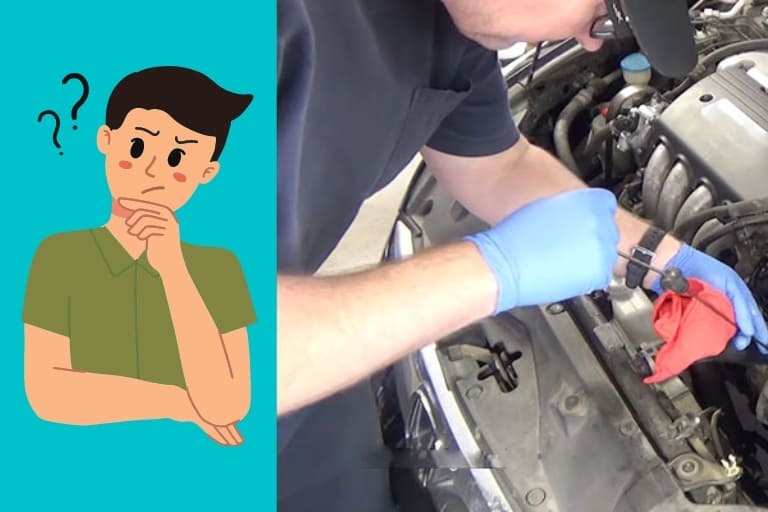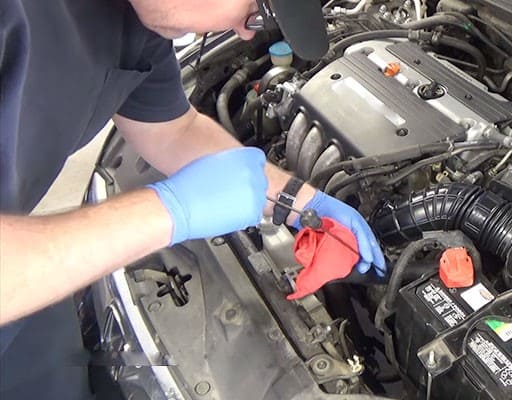Regular maintenance is crucial for the longevity and smooth operation of your vehicle. One of the essential components of your vehicle is the transmission, and one of the key ways to maintain it is by regularly flushing the transmission fluid.
The radiator in the transmission fluid system helps keep the fluid cool by dissipating heat. It helps to prevent overheating and damage to the transmission by regulating the temperature of the fluid. The radiator also filters out debris and impurities in the fluid, keeping the transmission running smoothly.
Regularly flushing the transmission fluid is vital for maintaining the health and longevity of your vehicle’s transmission. It helps to remove impurities and prolongs the life of the transmission by keeping it running smoothly.
In this blog post, we will discuss the importance of this maintenance task and explain the radiator’s function in the transmission fluid system.
By the end of this post, you will better understand the importance of regular transmission fluid flushes and how the radiator plays a vital role in maintaining the transmission’s health.
Contents
- 1 Why Flushing Transmission Fluid from The Radiator Is Necessary
- 2 How to Flush the Transmission Fluid from The Radiator
- 3 Precautions
- 4 Procedure
- 5 Alternative Methods for Flushing Transmission Fluid
- 6 FAQs
- 7 What happens if transmission fluid gets in the radiator?
- 8 Can transmission fluid get into the coolant?
- 9 Conclusion
Why Flushing Transmission Fluid from The Radiator Is Necessary

Maintaining clean transmission fluid is crucial for the health of the vehicle. The transmission fluid acts as a lubricant and a coolant, cleaner and power transfer medium.
Over time, contaminants such as dirt, metal shavings and other debris can build up in the radiator of the transmission fluid system. These contaminants can cause damage to the transmission by clogging the small passages and reducing the flow of fluid.
This can lead to overheating and increased wear on the transmission’s internal parts, resulting in reduced efficiency, decreased performance and even transmission failure.
Additionally, the build-up of contaminants can cause the fluid to lose its lubricating properties, which can cause further damage to the transmission.
By regularly flushing the transmission fluid, you can ensure that it is free of contaminants and able to perform its functions effectively, thus prolonging the life of the transmission and the vehicle overall.
How to Flush the Transmission Fluid from The Radiator
Step-by-Step Guide for Flushing the Transmission Fluid from the Radiator
Tools needed:

- Drain pan
- Funnel
- Transmission fluid pump or turkey baster
- New transmission fluid
- Essential hand tools (socket set, wrenches, etc.)
Precautions
- Always consult your vehicle’s owner’s manual for instructions before flushing the transmission fluid.
- Ensure the vehicle is parked on a level surface and the engine is off and cool before starting the process.
- Wear gloves and eye protection to prevent contact with the transmission fluid.
Procedure
- Step 1: Locate the transmission fluid drain plug and the radiator drain plug.
- Step 2: Place the drain pan under the transmission and radiator to catch the old fluid.
- Step 3: Remove the transmission fluid drain plug and allow the old fluid to drain completely.
- Step 4: Remove the radiator drain plug and allow the old fluid to drain completely.
- Step 5: Clean the drain plugs and reinstall them.
- Step 6: Using the transmission fluid pump or turkey baster, remove as much old fluid as possible from the transmission oil cooler lines.
- Step 7: Refill the transmission with new transmission fluid.
- Step 8: Run the engine and check the transmission fluid level. Adjust the level as necessary.
- Step 9: Drive the vehicle for a short distance and recheck the transmission fluid level.
It is recommended to repeat this process every 30,000 miles or as the vehicle’s manufacturer recommends.
By following this procedure and taking the necessary precautions, you can effectively flush the transmission fluid from the radiator and maintain the health of your vehicle’s transmission.
Alternative Methods for Flushing Transmission Fluid
Alternative Methods for Flushing Transmission Fluid are as follows:
- Power Flushing: Power flushing uses high-pressure pumps to force the old fluid out of the transmission, radiator, and oil cooler lines. This method is more efficient and can remove more debris and contaminants than the traditional method.
- Flushing with a Fluid Exchange Machine: A fluid exchange machine uses a combination of suction and pressure to flush the transmission fluid. This method is more efficient and can remove more contaminants than the traditional method.
- Transmission Flush Additive: Some transmission flush additives can be added to the transmission fluid to help loosen and remove debris and contaminants. This method is less effective than a traditional flush and should be used in addition to a regular flush.
Taking the Vehicle to A Professional Mechanic
Taking your vehicle to a professional mechanic for a transmission flush is a good option for those who are not comfortable doing the process themselves or prefer to have a professional handle the maintenance of their vehicle.
Professional mechanics will have the tools and equipment to flush the transmission fluid properly. They will also have the knowledge and experience to correctly diagnose any issues with the transmission and recommend the best course of action.
A professional mechanic will first inspect the transmission and check the transmission fluid level, color, and condition. They may also use specialized equipment, such as scanning tools, to check for transmission codes or diagnose potential issues.
Once the inspection is complete, the mechanic will proceed with the transmission flush. They will use the appropriate method, either traditional power flushing, fluid exchange machine, or transmission flush additive, and follow the manufacturer’s recommendations.
After the flush, the mechanic will refill the transmission with new fluid and check the fluid level.
Using a Transmission Flush Machine
A transmission flush machine is a specialized tool that can be used to flush the transmission fluid. This method is more efficient than the traditional method and can remove more contaminants. The machine uses a combination of suction and pressure to flush the fluid.
Not all vehicles are suitable for a transmission flush machine, so it’s essential to consult a professional mechanic or the vehicle’s manufacturer before using this method.
It’s important to note that flushing the transmission fluid can be a complex process requiring specialized tools and knowledge, so it is always recommended to consult a professional mechanic before using any alternative methods.
FAQs
Can I drain transmission fluid from radiator?
No, you cannot drain transmission fluid from the radiator. The radiator is only used to cool the engine coolant, and transmission fluid is not compatible with coolant. If you try to drain transmission fluid from the radiator, you could damage the radiator and the transmission.
What happens if transmission fluid gets in the radiator?
If transmission fluid gets in the radiator, it can cause several problems, including Corrosion of the radiator and other cooling system components, Reduced cooling efficiency, Damage to the transmission.
Can transmission fluid get into the coolant?
Yes, transmission fluid can get into the coolant. This can happen if there is a leak in the transmission cooler, which is a small radiator that helps to cool the transmission fluid. If the transmission cooler leaks, transmission fluid can seep into the coolant reservoir.
Also, read:
- Transmission Fluid Gushing Out: Causes & Solutions
- Transmission Fluid Leak when Parked on An Incline
- Transmission Fluid Leaking From U Joint
- Transmission vs Differential Fluid
- Is a Transmission Fluid Leak Covered Under Warranty
- Can You Add Transmission Fluid While the Car Is Off
- Water in Transmission Fluid: Symptoms & Solutions
- How Long Should I Drive Before Checking the Transmission Fluid
- Transmission Fluid vs Brake Fluid: What’s the Difference
- How to Change Transmission Fluid Like a Pro: Beginner’s Guide
- Choosing the Right Fluid: Transmission Fluid vs Coolant
- Is There a Warning Light for Low Transmission Fluid
- Mistakenly Put Transmission Fluid in The Oil: Is There Any Fix
- Can You Lose Transmission Fluid Without A Leak
Conclusion
In conclusion, regularly flushing the transmission fluid from the radiator is essential in maintaining the health and longevity of your vehicle’s transmission. Contaminants can build up in the radiator over time, which can cause damage to the transmission by clogging passages, reducing the flow, and reducing the lubricating properties of the fluid. This can lead to overheating, increased wear, decreased performance, and even transmission failure.
By regularly flushing the transmission fluid, you can ensure that it is free of contaminants and able to perform its functions effectively, thus prolonging the life of the transmission and the vehicle overall. There are different ways to flush the fluid, such as the traditional method, power flushing, fluid exchange machine, and transmission flush additive.
Each method has advantages and disadvantages, and it’s always recommended to consult a professional mechanic or the vehicle’s manufacturer before performing any transmission maintenance.
Maintaining clean transmission fluid is crucial for the overall health and function of the vehicle, and it’s an essential step in keeping your vehicle running at its best.
